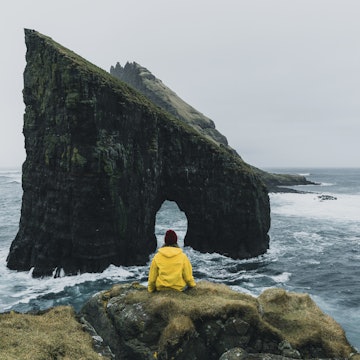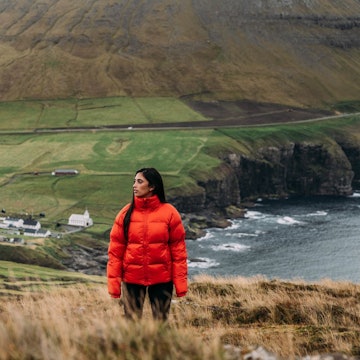

Get to know the Faroe Islands with these top places to visit © Bastian Linder / 500px / Getty Images
For once, you can have it all in one trip: waterfalls and superlative seafood restaurants, windy mountain roads and surf beaches.
The joy of being in the Faroe Islands – a small island group with a population of 53,000 and a total landmass of 1399 sq km – is that everything is close by. As long as the weather is on your side, you can see just about all of these key sights during a short break.
Travel here is highly seasonal and very weather dependent. You might plan to visit a certain island, but as to whether you will be able to or not during your stay… you’ll have to wait and see. Here are just a few of the must-visit spots of the Faroe Islands.
1. Múlafossur waterfall
Best for awesome nature
Until 2004, the only way you could get to the village of Gásadalur and the location of Múlafossur waterfall, was to walk the steep cairn-marked hiking trail over the mountain and back. Just ask the postie, who used to do it three times a week. Today, a tunnel links it with the road from Vágar airport, making it an easy first or last stop on your trip.
Park in the main car park and then follow the path down to the cliffs for views of the waterfall. You can feel the sea spray from the cliff top as you watch the torrent of water pour over the edge and shatter the sea below; in summer you might see a few fat-footed puffins flapping around the sandy, grassy cliffs here too.
Planning tip: Drop into the local shop, Uanni, for something special to take home, including hand-knitted jumpers from Faroese wool.

2. Tórshavn
Best for food
The capital of the Faroe Islands is a characterful place, with ancient alleyways, a colorful harbor and some great places to eat. If you’re looking for nightlife, bars, and shopping, this is where to go.
Mikkeller, an offshoot of the successful Danish microbrewery, doubles as a place to shelter and play board games in the rain; across from it down the wonky Gongin alley, Roks is the best place to eat on the island, now that its sister restaurant, Koks, has moved to Greenland. Expect everything from sea urchin roe to the long spindly legs of snow crabs, and dishes dusted with fish scales that look like confetti. Ræst, just down the street, also has a great reputation.
Planning tip: If you’re looking for something less extravagant, the city’s fish and chips scene is said to be the best in the country.
3. Tjørnuvík
Best for beach lovers
I have a soft spot for the remote village of Tjørnuvík on Streymoy, with its black-sand beach looking out to the sea stacks of Risin og Kellingin (the Giant and the Witch). It’s a sweet little village at the end of a long road winding through the hillsides, with a hike to the remote village of Saksun leading over the back of its mountains and a little surf shack offering lessons just off the beach.
It’s a place where you can discover antiques and whale bones in a little local shop, or buy waffles and coffee at a cafe. In winter, thanks to the dominating mountain behind it, Tjørnuvík is one of the few spots on the island to experience 24 hours of darkness. It feels like the setting for a dark historical drama or a strange love story.

4. Trelanípan
Best for easy hiking
You may have seen Lake Leitisvatn (also called Lake Sørvágsvatn) on social media – it’s one of the Faroe Islands’ most famous landscapes. In drone shots, taken from across the cliffs from the lake, it appears to hang suspended over the ocean thanks to an optical illusion. The hike to Trelanípan – the "Slave Cliff" – is currently one of the islands’ paid hiking routes, where you can walk on a relatively flat path through the old peat fields to the lake, and then on to the cliff with views of towering sea stacks including one named "The Witch’s Finger". It takes around an hour each way.
Planning tip: Guided tours bring the landscape alive and include grisly stories about Vikings and disobedient slaves who were thrown off the cliffs, along with tales of local myths and legends.
5. Gjógv
Best for coastal walks
The fishing village of Gjógv is named after its gorge, a great natural scar in the cliff that offers a safe harbor. It’s worth a visit for the drive there alone, on a road that swoops down the green sheep-filled hillsides to the sea. The road was created over 400 years ago, so a local told me, as a shortcut to the best fishing grounds.
Today the tiny village has whitewashed, turf-roofed houses, a little church and few inhabitants. If you walk down past the gorge you can catch a view of dark islands on the horizon and nesting birds in the cliffs in summer. There’s also a bench on the clifftop commemorating the 2005 visit of then Crown Princess Mary, now Queen Mary of Denmark. A moving statue in the village graveyard depicts a lady with two children looking out to sea, wondering if her husband will ever return.
Planning tip: There are lovely walks from Gjógv, including a 4km (2.5 mile) hike to Funningur, a quiet seaside village at the foot of the Faroes’ highest mountain. Allow a half day to get there and back.
6. Dranganir sea arch
Best for drama
The natural sea arch of Dranganir is on an island shaped like a triangle just off the coast of Bøur. You can admire it from the shore or take a boat ride around it and the neighboring island of Tindhólmur. Birds breed on the basalt cliffs in spring and summer, and the sea rages around the sea stacks all year round, adding a little more drama to the mix.
Planning tip: Ferry trips to the popular puffin island of Mykines come back via the sea arch, giving you two attractions in one. Book this trip early in your stay so if it is canceled due to bad weather you can hopefully rebook for a calmer day.

7. Kalsoy
Best for Bond enthusiasts
In the northeast of the Faroe Islands, Kalsoy is accessible by car ferry from Klaksvík. Its claim to fame is its starring role in the 2021 James Bond film No Time To Die. Daniel Craig’s James Bond dies standing on Kallurin looking out to the horizon, on the hiking path that leads to the islands’ lighthouse. Enterprising tourism people have erected a tombstone in his memory, etched with the words: “The proper function of man is to live, not to exist.” Adventurers visiting this epic spot in the Faroe Islands will surely nod their heads in agreement.
8. Sandoy
Best for off the beaten track
Sandoy has always been connected to the rest of the archipelago by ferry, but from the start of 2024, its new undersea tunnel has put this southerly island on the map. Tour the tiny villages, try dining with some locals and don’t miss the island’s claim to fame: a yarn-bombed rock.
Planning tip: For a superlative bird-watching experience, and an alternative to the popular Mykines trip, take a boat trip from Sandoy to the island of Skúvoy. The island is named after the Great Skua, many of which nest there.














